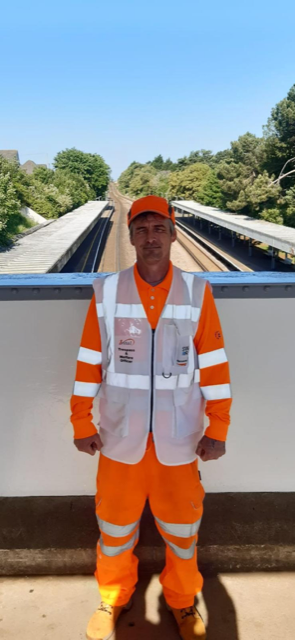Trespass & Welfare Officers – Network Rail & South Western Railway joint project Wessex Route
What is the issue being addressed?
Network Rail (NR) Wessex Route and South Western Railway (SWR) experienced a rise of up to 50% in trespass and fatality incidents, which caused delays and disruption to passengers, and distress to train drivers.
In particular, in 2019 there was an increase in the number of trespass incidents at Clapham, Woking and Pokesdown, and approx 8% of SWR train drivers working at Weymouth and Bournemouth train depots had to take time off work due to trespass and fatality related incidents.
SWR and NR identified a need for a solution to the worrying trend of increases in trespass incidents and the number of people who want to take their own life on the railway.
How was the issue solved?
 A joint initiative was set up between NR and SWR. This saw the introduction of Trespass & Welfare (T&W) officers at a number of stations on the route in July 2019.
A joint initiative was set up between NR and SWR. This saw the introduction of Trespass & Welfare (T&W) officers at a number of stations on the route in July 2019.
The Joint Performance Improvement Centre (JPIC) carried out detailed analysis of trespass, fatality data, 'concern for welfare' incidents, and crime. This identified critical areas where incidents caused the most disruption and delay to the railway.
Supported by the data, as well as local intelligence, NR & SWR deployed a team of T&W officers at the stations which had the highest number of incidents.
The T&W officers provide a highly visible presence at stations as they wear a distinct tunic. They are approachable while on the platforms or within stations and will engage with customers while remaining vigilant. They will support those that are deemed to be vulnerable and, when safe to do so, make a physical intervention to avoid incidents.
All T&W officers attended the Samaritans’ Managing Suicidal Contacts course.
The project has developed over the last year and there are now over 100 T&W officers along the Wessex route. They are deployed either statically (at 49 locations) or as part of five mobile teams that visit a further 48 station locations.
Each location has one or more staff and the number of T&W officers deployed, is based on historical incident data and its associated effect on delay minutes.
Additionally, NR & SWR continually share incident data for all incidents across the route to ensure any changes to, or new risks identified, so that T&W officers can be deployed where they are needed.
The T&W officers are generally on duty Monday to Saturday between 0600-2200.
What were the outcomes / key
Since the T&W officers were introduced in July 2019:
- Successful interventions: there have been 20 physical interventions where an individual was deterred from trespass and given assistance by a T&W officer.
- Performance benefits: since the initial trial was launched, there have been a total of 130 crisis interventions recorded at locations across the network. (A crisis intervention is an immediate and short-term emergency response to mental, emotional, physical, and behavioural distress.)
- NR & SWR estimate that if 33% of the incidents had materialised, this would have resulted in approximately 86,000 minutes of delays to trains affecting 1,935 trains and over 1,451,000 passengers would have experienced a delay or cancellation to their train.
- Enhanced customer experience: the T&W officers also deliver an enhanced customer experience. Where possible, they support SWR employees by providing customers with directions and information, assist elderly passengers with their baggage and families with prams, and help keep passengers behind the yellow line (safety aspect).
- Data analysis: we continually monitor the latest data, as well as analyse incident reports, as well as local intelligence, to determine where T&W officers are sent.
- Employees’ welfare: the T&W officers presence provides reassurance to SWR Drivers when passing through the station and for our station colleagues.
- Early analysis has also shown a huge reduction in passenger injuries, for example, last year at both Southampton and Bournemouth we have experienced 30% fewer injuries. Simply by reminding people not to approach a moving train or ride a bicycle on a platform or helping a passenger with a bag, has greatly improved the passenger experience and reduced the likelihood of an accident.
Lessons learnt
This project is first and foremost data led. It is reliant on good quality collaboration between stakeholders to gain and share insights on where to locate T&W officers. It is important to have the flexibility to respond to any changes in trends by reviewing the patrol pattern or area of coverage of the officers, based on a changing landscape.
Since the introduction of the T&W officers, the Wessex route has seen the displacement of suicidal related incidents from station platforms to adjacent bridges. This has supported the business case for physical mitigation measures and installation works being approved but also providing mobile capability in the instances where all stations in the area are not covered.
We have seen the benefit of improved intelligence reporting between the T&W officers, SWR and BTP. This was vital to allow more detailed information on repeat offenders, vulnerable people and specific allocations (days of the week, time of the day).
Ability to share 'sanitized' information with the T&W officers of prevalent individuals who regularly trespass at the particular stations they are responsible for. This has allowed the T&W officers to be better prepared and take preventative action should the individuals visit that location.
Contact
Helen Yorke, NR Route Crime Manager
Alessandro Finistrella, SWR Senior Security & Route Crime Manager

